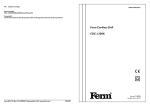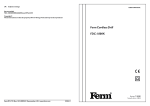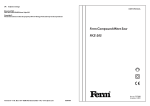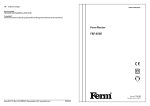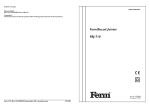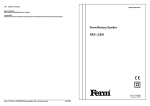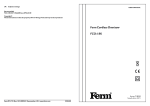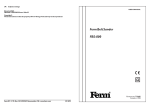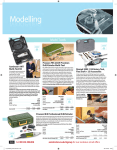Download Ferm Soldering Kit FSK-100
Transcript
UK Subject to change USER’S MANUAL Document Ref: FSK-100/12031/PMR39/Issue 1/June 02 Copyright © These instructions are the sole property of Ferm-Omega Tools and may not be reproduced Ferm Soldering Kit FSK-100 Art.nr. 785640 Screwfix Art.nr. 12031 Ferm BV • P.O. Box 134 • 8280 AC Genemuiden • NL • www.ferm.com 0301-27 SAFETY INSTRUCTIONS The following symbols are used in these instructions for use: FERM SOLDERING SET FSK-100 USERS MANUAL TECHNICAL SPECIFICATIONS Voltage Frequency Power consumption: soldering gun Power consumption: soldering iron: Intermittent service Type of protection Weight | | | | | | | 230 V~ 50 Hz 100 W 30 W 12 s / 48 s II approx. 0.6 kg PRODUCT INFORMATION Denotes risk of personal injury, loss of life or damage to the tool in case of non-observance of the instructions in this manual. Denotes risk of electric shock. Denotes risk of fire. Carefully read this manual before using the machine. Make sure that you know how the machine functions and how to operate it. Maintain the machine in accordance with the instructions to make sure it functions properly. Keep this manual and the enclosed documentation with the machine. Ferm products are manufactured to high quality standards they are safe and fit for purpose at time of sale, but all tools can be dangerous if the correct precautions are not taken. Always follow these instructions, do not carry out the operation until you are sure you can do so in safety. Remember to consider the work environment for safe operation as well as safety for tool use. Warning! When using electric tools, basic safety precautions should always be followed to reduce the risk of fire, electric shock and personal injury. Read all these instructions before attempting to operate this product. Save these instructions for future reference. 1. Tip 2. Fixing screw 3. Status indicator 4. Switch 5. Handle 6. Power supply lead PACKAGE CONTENTS When unpacking, you will find the following parts in the plastic packaging: 1 Soldering gun with tip 1 Soldering iron 1 Soldering help with magnifying glass 1 Solder suction tool 1 Stand for soldering iron 1 Roll of solder 1 Soldering paste 1 Terminal pin 1 Spare tip 1 Operating instructions Check all parts for shipping damage. Should you detect any damage, or should any parts be missing, please notify the dealer from whom the machine was bought. 2 PERSONAL SAFETY Use Personal Protection Safety Equipment Protect eyes with safety glasses or goggles note: the use of safety protective eyewear without the CE mark can lead to serious injury if the glass breaks. A suitable mask should be worn if cutting, drilling or sanding is dusty, in particular chipboard or MDF. Approved safety footwear and headgear should worn as appropriate, for example on building works or when heavy weights are involved. Dress properly Do not wear loose clothing or jewellery. It can get caught in moving parts. Non-skid footwear is recommended when working out doors. Wear protective hair covering to contain long hair. Stay alert Watch what you are doing Use common sense. Do not operate tools when tired or after taking alcohol or prescription/ non-prescription drugs. Ferm Ferm 7 ELECTRICAL INFORMATION These products are complete with pre-wired mains plugs. If a plug needs replacing follow these instructions. Wire correctly The wires in the mains lead are coloured in the following way: BLUE • Neutral BROWN • Live GREEN/YELLOW • Earth Green & Yellow (Earth) Fuse (13 Amp) GUARANTEE The guarantee conditions can be found on the separately enclosed guarantee card. CEı DECLARATION OF CONFORMITY (UK) We declare under our sole responsibility that this product is in conformity with the following standards or standardized documents OPERATIONAL SAFETY Warning! Soldering guns and irons are very hot and can cause burns. Lead solder and its fumes are toxic. Do not leave soldering guns/irons unattended when switched on. Keep soldering equipment away from children and animals Use appropriate personal protection equipment. Concentrate Routine and repetition can lead to mistakes. Remember that a slight lack of concentration can result in serious injuries in a split second. Keep work area clean Cluttered areas and benches invite injuries. EN55014-1, EN-55014-2, EN61000-3-2, EN61000-3-3, EN60335-1, EN60335-2-45, Remove adjusting keys and wrenches Ensure that they are removed from the tool before switching on. Avoid unintentional starting Do not carry plugged in tools with your finger on the switch. Check that the switch is off before plugging in to socket. Extension cables Use only three core earthed extension cables suitable for the power input of the tool (minimum cable size 1.5mm2). Plug into an earthed socket only. When using a cable reel unwind it fully. Do not use long extension cables. Consider the work environment Do not expose power tools to rain or use them in damp or wet locations. Keep work area well lit. Do not use power tools in the presence of flammable liquids, vapours or gases. Outdoors use If the tool is suitable to be used outdoors, only use an extension cable intended for outdoor use and marked accordingly. Use a RCD (residual current device) to provide protection against electrical shock. Do not use in rain or damp conditions. Guard against electric shock This unit contains dangerous voltages. Use a RCD (residual current device) to provide protection against electrical shock. Prevent body contact with grounded surfaces (e.g. pipes, radiator, ranges or refrigerators). Connect a fume extraction device Make sure you use fume extraction device when soldering. Recycle/Dispose of old plug and cable Prevent inadvertent connection to socket and risk of electric shock. If in doubt always consult a Qualified Electrician Keep children and pets away Do not let children or pets come into contact with the tool, extension cable or work area. Use recommended accessories The use of any other accessory or attachment other than recommended in the instructions or catalogue may present a risk of personal injury. Do not use long extension cables with the soldering gun/iron. ENVIROMENT At the end of this products or its accessories life, please recycle where facilities exist. Recycle the packaging according the identification marks on the individual items. Phone the Helpline for current advice on recycling. Do not force the tool It will work better and safer at the rate for which it was intended. Blue (Neutral) Brown (Live) Securing wires Secure wires carefully and firmly to the correct terminals. Secure the mains cable in the plug cord grip firmly Fit a 13-amp fuse. If a 13amp (BS1363) plug is used a (BS 1362) ASTA approved 3-amp fuse must be fitted. in accordance with the regulations. 73/23/EEC, 89/336EEC from 04-10-2001 GENEMUIDEN NL W. Kamphof Quality department Use the right tool Do not force small tools or attachments to do the job of a heavy-duty tool. Do not use tools for purposes for which they were not intended; for example do not use a circular saw for cutting trees or logs. Helpline For any questions relating to operational or safety matters contact: Ferm Customer Helpline on: 0115 966 1199 Monday-Friday 8am – 6pm Saturday 9am – 1 pm Do not abuse the cable Never carry the tool by the cable or pull it to disconnect it from the power socket. Keep the cable away from heat, oil and sharp edges. Do not touch the metal plug pins when connecting or removing the plug. Secure work Use clamps or a vice to hold work. It is safer than using your hand and it frees both hands to operate the tool. BEFORE USING THE SOLDERING KIT Check package contents Check contents against list in this manual to make sure each item is present. Check for damage Before using this item check each part listed is undamaged. Save packaging Save major packaging for return of product for service or repair. Fully assemble Ensure each item is fully and correctly assembled before use. Do not over-reach Keep a proper footing and balance at all times. Disconnect tools from power supply When not in use, before servicing and when changing accessories such as blades, bits and cutters. Always switch off and unplug the soldering gun/iron from the power supply before making adjustments or changing tips. 6 Ferm Ferm 3 USING THE SOLDERING GUN Ensure the gun is switched off and unplugged. Refer to illustration page 2. BEFORE OPERATING Check the voltage on the soldering gun corresponds with your power supply voltage and that the plug and lead are in good condition. OPERATION Place the iron in a safe rest position so that the tip is not touching any surface. Use the stand supplied. To switch the gun ON • Plug into a suitable main supply and switch on at socket. • Press the switch (4) on the soldering gun the indicator light (3) will light up. To switch OFF • Release switch (4) • • • • During operation you must keep the switch depressed to heat the tip, the longer the switch is depressed the higher the soldering temperature. To find the right amount of time to keep the switch depressed, practice with the components and solder being used before starting the job. As a guide to achieve a constant temperature do not keep the switch depressed for more than 12 seconds or released for more than 48 seconds. A constant tip temperature produces consistent quality joints and extends the life of the tip. USING THE SOLDERING IRON Ensure the iron is unplugged. BEFORE OPERATING Check the voltage on the soldering iron corresponds with your power supply voltage and that the plug and lead are in good condition. OPERATION Place the iron in a safe rest position so that the tip is not touching any surface. Use the stand supplied. To switch iron ON • Plug into a suitable main supply and switch on at socket. • The iron will reach operating temperature after a short time. SOLDERING SAFETY • Plug into a suitable main supply and switch on at socket. The lead content of solder/flux and the fumes produced are toxic to you and the environment. The solder, components, tips and shafts of the iron and gun get hot enough to burn you. WHEN USING THIS EQUIPMENT • Wear a suitable fume mask. • Use fume extraction/ventilation • Wear safety glasses and gloves. • Avoid wearing contact lenses • Keep your arms and other exposed skin covered to protect against splashes of hot solder/flux. • Hold components with soldering clamp, pliers or vice. • Do not eat, drink or smoke while using this equipment or in the work area • While working do not leave this equipment unattended, always store it securely in the original containers. • Dispose of waste solder and other material in a responsible way. Seek advice on waste disposal from your local authority or the Helpline SOLDERING WITH THE IRON AND GUN There are a number of different types of solder and flux available for different types of soldering jobs, always consult your supplier or the manufacturer about the correct soldering materials to use for the job in hand. • Before you start, the components to be soldered must be clean. • Remove oxidation and dirt with abrasive paper, wire wool, files or wire brushes. • Degrease the components with methylated spirit or similar. Take care highly flammable! • Tin the tip. With the iron or gun switched off clean the tip with wire wool, switch on, heat up and apply flux and solder to coat the tip. • Ensure the components to be soldered are firmly held. Twist wires, clamp or fix as appropriate. • Apply flux if required, heat up the joint with the tip, and then apply a small amount of solder to the tip/joint. • Heat for as little time as possible to enable the solder to flow onto the joint. • Allow the joint to cool without moving it, about 10 to 15 seconds depending on the size of the components. INSPECT THE JOINT • A good joint should be shiny and smooth. • If the joint has tear shaped lumps on it, the solder was not hot enough. • If the solder looks dull or crystalline, the components were moved during soldering. • If there is little solder in the joint, more heat is needed. • If the joint shows yellow or black, either too much paste has been used or the solder has been overheated. SOLDERING PRINTED CIRCUITS The connectors and miniature components of printed circuit boards are very temperature sensitive and can be easily damaged. Be aware that heat and soldering work can damage the components. Do not attempt to solder these components unless you competent to do so. Follow these points: • Prepare the job. Clean as directed. • Pre-assemble the components • Secure the board or components • Use top quality solder and anti-corrosive flux. • Do not apply surplus solder. • Keep the soldering time as short as possible. • Follow the component manufacturers advice on how to solder the item. USING THE GUN FOR PYROGRAPHY AND PLASTIC WORK The soldering gun can be used for Pyrography (heat engraving of wood, leather and other materials) and also for working/cutting plastic items. The same safety guidelines apply as in the Soldering Safety section. • Be aware that different materials react to heat in different ways, so always practice on a piece of scrap first and do not proceed with the job until you are sure you are competent to do so. • With the gun switched off and unplugged, clean the tip. • Switch on and warm up the tip. • Test for performance on the material, if the temperature is too high the will burn quickly. Adjust the heating time accordingly. • Do not heat the tip for long periods i.e. more than 60 seconds at a time. MAINTENCE, CARE AND REPAIR Ensure the soldering iron/gun is switched off and unplugged. CLEANING Clean with a soft brush or damp cloth, dry off afterwards. Do not use flammable liquids like methylated spirits to clean the soldering gun/iron; they can damage the plastic parts. FAULTS Switch OFF immediately at the mains plug and remove the plug when: • The plug or cable is damaged. • The switch on the hot air gun is defective. • You smell or see smoke caused by scorched insulation in the soldering gun/iron. Overheating • The ventilation slots are blocked with dirt. Clean with brush/dry cloth. The soldering gun does not heat when switched on • Check the mains lead and the fuse/plug. • Take to your Ferm Dealer for repair. • The heater element is defective. Take to your Ferm Dealer. MAINTAIN TOOLS WITH CARE Keep the tools clean for better and safer performance. Follow instructions for changing accessories. Inspect tool and extension cables periodically and if damaged, have them repaired by a qualified person or authorised service body. Keep handles free from oil or grease. Keep the ventilation slots clean to prevent motor overheating. Check for damaged parts Do not use a tool with damaged parts, before further use a damaged tool must be carefully checked by a qualified person to determine that it will operate properly. Check for alignment of moving parts, binding or breakage of parts, mounting and other conditions that may affect its operation. A damaged part or guard should be properly repaired by an authorised service centre, unless indicated otherwise in the instruction manual. Have defective switches replaced by an authorised service centre. Do not use a tool if the switch does not turn on and off. Have your tool repaired by an expert This appliance is manufactured in accordance with relevant safety standards. Only experts must carry out repairing of electrical appliances, otherwise considerable danger for the user may result. To switch OFF • Switch off at socket and remove plug. Storing tools When not in use tools should be stored in the dry, out of reach of children. 4 Ferm Ferm 5




